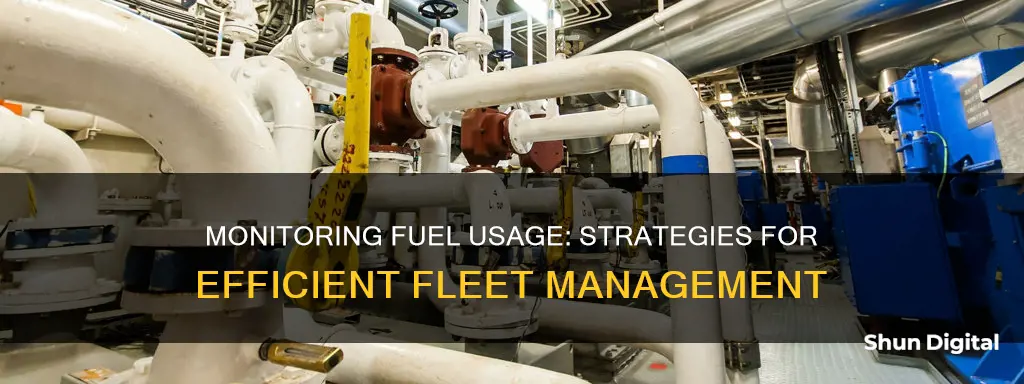
Monitoring fuel usage is an important aspect of managing a business or personal vehicle fleet. It can help save money by reducing fuel consumption, and also protect against fuel theft and contamination. There are several techniques for monitoring fuel usage, including fuel level sensors, GPS tracking devices, fuel cards, and telematics systems. Fuel level sensors can be installed in vehicles or fuel storage tanks to provide real-time data on fuel levels, while GPS tracking devices can help determine the most efficient routes to reduce fuel consumption. Fuel cards provide a secure way of paying for fuel and allow for monitoring of fuel consumption and cost. Telematics systems collect data on various aspects of vehicle performance, such as fuel consumption, engine hours, and mileage, enabling informed decisions about fuel usage. By implementing these techniques, businesses and individuals can gain a better understanding of their fuel usage, reduce consumption, increase efficiency, and protect their resources.
| Characteristics | Values |
|---|---|
| Purpose | To save money, prevent fuel theft and contamination, and ensure resources are being used efficiently and effectively |
| Techniques | Fuel level sensors, GPS tracking devices, fuel cards, telematics systems |
| Strategies | Eco-driving techniques, maintaining vehicles, optimising routes, downsizing the fleet |
| Solutions | Locks and alarms, surveillance cameras, digital control and access, fuel management systems |
What You'll Learn

Utilise fuel level sensors
Fuel level sensors are devices installed inside fuel tanks to measure fuel levels in real time. They are also known as fuel gauges or fuel level indicators. The data is then shared with telematics software, which presents the information in a digestible format.
There are several types of fuel level sensors, including:
- Capacitance Fuel Level Sensors: These have two electrodes at each end of the fuel tank. The capacitance between the electrodes changes as fuel levels change, and this change in value is converted into fuel level readings. They are accurate, less susceptible to fuel sloshing and sedimentation, and suitable for both liquid and gas fuels.
- Ultrasonic Fuel Sensors: Ultrasonic sensors use sound waves to measure fuel levels. They emit sound waves towards the fuel surface, and the time taken for the waves to reflect back determines the distance and, therefore, the fuel level. They offer contactless measurement and are suitable for fuel tanks of different shapes and sizes. However, they can be expensive, and foam may compromise the reading.
- Resistive or Float Fuel Indicators: A float is connected to a potentiometer or a variable resistor that moves as the fuel level changes, resulting in a change in voltage. The dashboard then displays the calibrated value in litres. This type of sensor is cost-effective and easily compatible with a wide range of fuel management systems, but its values can be flawed due to fuel sloshing.
- Magnetic Fuel Tank Sensors: These sensors, also known as Hall effect fuel sensors, detect changes in the magnetic field. They offer accurate, non-contact fuel measurement even in asymmetric fuel tanks, but they are more expensive and have limited compatibility with fuel types.
Fuel level sensors offer several benefits, including improved fuel management, increased vehicle efficiency, enhanced vehicle and consignment safety, and reduced stress on the environment. They can also help prevent fuel theft, which is a common issue for fleet owners.
Monitoring Bandwidth Usage: Tips for Home Network Management
You may want to see also

Install GPS tracking devices
Installing GPS tracking devices is an effective way to monitor fuel usage and gain valuable insights into your fleet's fuel efficiency and performance. Here are some key benefits of using GPS tracking for fuel monitoring:
Real-Time Fuel Level Monitoring
GPS tracking systems, combined with fuel sensors, provide accurate and real-time data on fuel levels in the tank. This helps fleet owners and managers stay informed about fuel consumption per time period and verify fuel bills and refill volumes.
Fuel Theft Protection
GPS tracking devices help identify fuel theft events by detecting sudden fuel level drops. Real-time notifications and alerts can be set up to notify you of high or low fuel levels, and even show refuel and drain locations on a map. This enables you to catch thieves in the act and prevent significant financial losses.
Detailed Reports and Analytics
GPS tracking platforms offer detailed fuel level and consumption reports, providing insights into total fuel consumed, fuel level at trip start and end, average fuel consumption, refuelling and draining events, and more. These reports help identify suspicious activities and inefficiencies, enabling better decision-making and cost control.
Vehicle Misuse and Idling
GPS tracking data helps identify vehicle misuse, such as personal errands or after-hours side jobs, by providing historical tracking information. Additionally, idling is a significant contributor to fuel costs, and GPS monitoring can help identify drivers who idle excessively. This information can be used to create incentive programs that reward drivers for low idling rates.
Maintenance and Fuel Efficiency
GPS tracking systems can also be used to monitor vehicle health and maintenance needs. By identifying small issues proactively, you can prevent breakdowns and improve fuel efficiency by keeping your vehicles running at maximum efficiency. This data can also help make informed decisions about vehicle replacements, as well as identify vehicles suitable for electrification to improve fuel efficiency.
Overall, installing GPS tracking devices with fuel sensors provides fleet owners and managers with valuable data to optimize fuel usage, reduce costs, and improve overall fleet performance and sustainability.
Monitoring Bandwidth Usage by IP on SonicWall
You may want to see also

Implement telematics systems
Telematics systems are an effective way to monitor fuel usage and can be used in conjunction with other methods such as fuel flowmeters and fuel level sensors. These systems are particularly useful for businesses that rely on a fleet of vehicles, helping to reduce costs, environmental impact, and improve competitiveness.
Telematics systems use a combination of hardware and software to monitor and manage fuel consumption. They can track data such as vehicle speed, location, mileage, and fuel level, and transmit this information to a central system for analysis. This data can be used to identify areas where fuel usage can be optimised, detect fuel theft, and improve overall fleet efficiency.
Benefits of telematics systems for fuel monitoring:
- Accurate fuel usage data: Telematics systems provide real-time data on fuel consumption, allowing for better decision-making and cost management.
- Detection of fuel theft: By monitoring fuel levels and usage patterns, these systems can identify suspicious activities and help prevent fuel theft, a significant problem for many businesses.
- Improved fleet efficiency: With detailed fuel consumption data, fleet managers can identify high-risk driving behaviours that increase fuel usage, such as speeding, rapid acceleration, and braking. This information can then be used to implement behavioural changes and improve fuel economy.
- Reduced labour costs: Telematics systems automate the fuel monitoring process, reducing the need for manual recording and labour-intensive processes.
- Powerful insights: Advanced telematics systems use AI to provide valuable insights and guide business decisions, helping to further optimise fuel usage and costs.
Types of telematics systems:
- CAN bus data: This method reads fuel levels from the Controller Area Network (CAN) bus, tracking and analysing data from the vehicle's CAN bus to measure fuel usage. It is often chosen by car-sharing providers as it allows for charging based on distance or time of use.
- OBD trackers: OBD tracking devices collect standard on-board diagnostics and OEM data, including real-time fuel level, RPM, engine temperature, vehicle speed, and engine load. They are ideal for cars and vans, providing an easy-to-use solution for fuel level monitoring.
- Fuel level sensors: For accurate fuel monitoring in light commercial vehicles, trucks, and lorries, fuel level sensors are recommended. They offer several ways to output fuel data, including digital, analogue, and pulse counter methods, providing comprehensive support for fuel-efficient driving habits.
Choosing a telematics system:
When choosing a telematics system, consider the specific needs of your business and fleet. Different systems may be more suitable depending on the type of vehicles and tanks used. For example, fuel level sensors may be challenging to install on non-standard tanks, while OBD trackers are ideal for cars and vans. Additionally, consider the level of accuracy required and the ease of installation and maintenance.
By implementing a telematics system, businesses can effectively monitor and manage their fuel usage, leading to reduced costs, improved efficiency, and a reduced environmental impact.
Monitoring Bandwidth Usage: PRTG's Per-IP Address Insights
You may want to see also

Monitor fuel transaction reconciliation and suspicious fuel events
Monitoring fuel transactions and keeping an eye on suspicious fuel events is crucial for any organisation with a fleet of vehicles. Fuel is often one of the highest expenses for such operations, and inadequate monitoring can lead to fuel loss and excessive spending. Fuel theft, poor vehicle condition, and risky driving behaviours are some of the factors that contribute to higher fuel usage and costs.
Reconciliation of fuel transactions is a vital process to ensure that your operation gets what it pays for. It involves comparing point-of-service metered sales with actual tank inventories from electronic tank monitors or measured stick readings. Regular fuel reconciliation helps in controlling shrinkage, ensuring correct product delivery, improving environmental compliance, and reducing administrative time.
To effectively monitor fuel transactions and suspicious fuel events, consider implementing a fuel consumption monitoring system. This system can help in detecting fuel level and volume changes in fuel tanks, providing data from the CAN J1939 bus, or measuring fuel flow rate in the engine's fuel lines. Additionally, telematics systems, monitoring software, and fuel fleet card programs are commonly used strategies to manage fuel consumption.
Tourmo's Fuel & CO2 solution is an advanced platform that can automatically reconcile fuel transactions and identify suspicious activities. It tracks fuel purchased, fuel loaded into vehicles, use of fuel, and unaccounted-for fuel to highlight suspicious events. This AI-powered platform also helps prevent record-keeping errors and eliminate employee fuel theft and improper fuel card usage.
By utilising Tourmo's platform, organisations can benefit from improved fuel efficiency, reduced fuel costs, and enhanced reporting and fuel efficiency. It is important to choose a solution that suits your specific needs and can help you stay ahead of volatile fuel prices.
Monitor Bandwidth and Data Usage Like a Geek
You may want to see also

Use fuel cards
Fuel cards are a great way to monitor fuel usage and can be a very secure method of payment. They are a more modern alternative to the old paper receipts of legacy fuel monitoring programs. With fuel cards, purchases are automatically recorded, including digital copies of any receipts, so expenses don't get lost or forgotten. This makes record-keeping much simpler for drivers.
Fuel cards also allow you to monitor fuel consumption, fuel cost, and track your vehicles. This can be very useful for businesses, helping them to monitor fuel usage patterns and establish more efficient routes, better driving practices, and possibly downsize the fleet.
Fuel cards can also be used to establish spending controls and create rules and guidelines for drivers. They are a great way to ensure drivers purchase fuel promptly and efficiently. Giving one or two employees the responsibility of taking the fuel monitoring data, analysing it, and finding ways to manage fuel purchasing can help ensure that cost-cutting measures aren't being overlooked.
Fuel cards can also be used to build driver accountability. By setting clear expectations and guidelines for drivers, and then creating incentives and rewards for those who exhibit behaviours that result in high fuel efficiency and low spending, you can get drivers involved in the process of reducing fuel costs.
Monitoring Data Usage: Xfinity Router Guide
You may want to see also
Frequently asked questions
Fuel consumption is the measure of gallons used vs distance travelled. It requires an accurate recording of vehicle and fuel data.
Fuel consumption can be measured manually by recording the amount of fuel used and the distance travelled. However, it is more commonly tracked with technology, such as GPS, telematics systems, fuel flowmeters, and fuel level sensors.
Monitoring fuel usage can help to save money by reducing fuel consumption, and it can also help to protect against fuel theft and contamination. It can also help to identify patterns or areas for improvement.
There are several techniques available to monitor fuel usage, including fuel level sensors, GPS tracking devices, fuel cards, and telematics systems.







